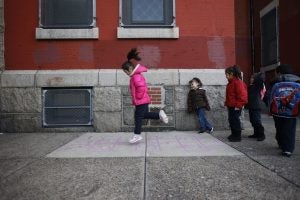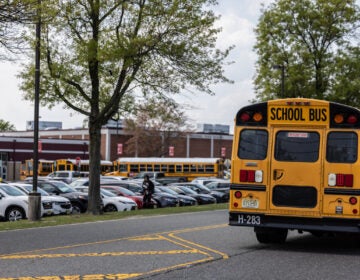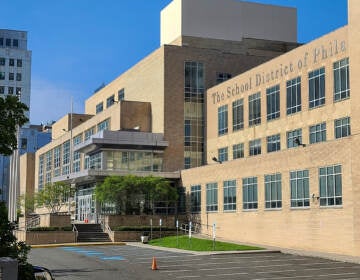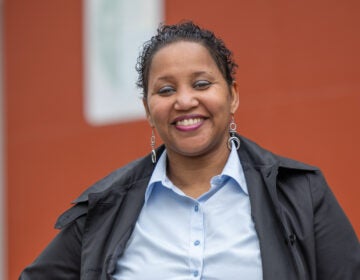When it comes to education funding, what’s the deal with Philly schools?
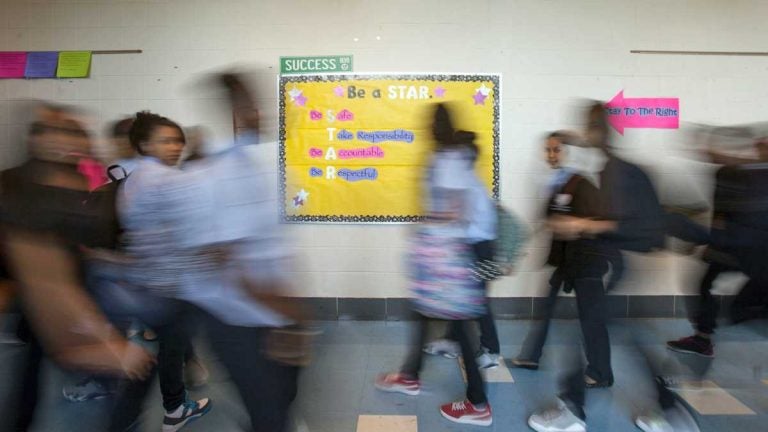
Students at the Young Women's Academy at Fentonville Arts and Sciences middle school change classes in Philadelphia. (Jessica Kourkounis for Keystone Crossroads)
The district’s budget for the 2014-15 school year is roughly $2.6 billion. The SRC and Superintendent William Hite have proposed a $2.89 billion plan for next school year.
Fourteenth in an occasional series of podcasts and web “explainers.”
How much does the Philadelphia School District spend?
The district’s budget for the 2014-15 school year is roughly $2.6 billion. The School Reform Commission and Superintendent William Hite have proposed a $2.89 billion plan for the 2015-16 school year, arguing that the additional money is needed to restore vital, basic services.
Doesn’t Philadelphia get a huge share of state education aid already?
House Majority Leader Mike Turzai (R- Allegheny) makes the point that the city has 12 percent of the state’s school population, but receives 18 percent of the state’s basic education subsidy.
That’s accurate.
Philadelphia school officials counter that those numbers alone don’t capture the situation. They cite several reasons. First, Pennsylvania chips in a smaller share of education funding than most other states, so there is less state aid to balance out unequal tax bases among districts.
Also, they say, the state’s school aid system is supposed to send more help to districts that have a lot of impoverished families with children who pose extra challenges to educate. Philadelphia educates more children from low-income backgrounds than any other district. More than 80 percent of Philadelphia students are eligible for free or reduced-price lunch, almost twice the statewide average of 43 percent.
Such a high concentration of poverty comes with added education costs, since it typically requires more remedial work, more need for counseling and violence prevention, and more special education programs.
Doesn’t Philadelphia spend a lot more on education than other districts?
In terms of total dollars, it obviously spends more, because it educates 12 percent of the students in a state with 500 other much smaller school districts. The next largest district, Pittsburgh, is about one-eighth the size, with roughly 25,000 students. But the more revealing number comes from dividing the overall budget by the number of students.
On this per-pupil basis, Philadelphia’s spending is nowhere near the top statewide. In fact, it’s below the median for Pennsylvania districts. Also, a report by the Pew Charitable Trusts calculated Philadelphia’s per pupil spending for the 2013-14 at $12,570, less than is spent in Baltimore, Cleveland, Detroit, Chicago, Milwaukee, Boston and Detroit.
Shouldn’t some of that money be going to charter schools instead?
It does. About 30 percent of the School District’s operating budget, roughly $750 million, goes to charter schools, which educate about a third of the city’s students. This, however, is not a neat trade-off. For instance, when charter students come from private or religious schools or from outside the district, the district still has to pay charters to educate them, without any offsetting savings for traditional schools.
What’s more, the savings the traditional school district does derive when one of its students transfers to a charter are often overestimated by charter schools’ political advocates.
Students don’t leave traditional schools for charters in neat bundles of 30 or so students. When only a couple of students leave a traditional school for charters in a given year, that limits opportunity to cut costs by trimming staff or services.
For these reasons, charters have been a financial drain on Philadelphia and other districts with large charter sectors. Until 2011, the state reimbursed districts for part of this cost, but former Gov. Corbett’s education cuts eliminated $100 million in charter reimbursements to Philadelphia. Gov. Tom Wolf seeks to restore some of that funding in his budget proposal, which is still being debated in the General Assembly.
Doesn’t politics play a role in this?
Yes. “It’s easy to beat up on Philadelphia,” says Phil Goldsmith, who served as interim CEO of the School District in 2000 and 2001 and as the city’s managing director from 2003 to 2005. “No one in another legislative district is going to lose their election because they didn’t give money to Philadelphia.”
The city is heavily Democratic in a state where both houses of the General Assembly are Republican-controlled. Philadelphia has only two members in the House Republican majority caucus, and no one in the Senate majority caucus.
Goldsmith speculates that the General Assembly has little incentive to change the state law governing charter schools in a way that would ease the financial burden on school districts because it is considered mostly a “Philadelphia issue.” Philadelphia has half the charters in the state, and few other districts have as large a percentage of the school population in charters.
Does it matter that Philadelphia is both a city and a county?
Absolutely. Counties in Pennsylvania are responsible for court and prison costs. Because Philadelphia is both a city and a county, it must bear the entire burden for supporting these expensive systems without any help from its suburbs. Compare that to Pittsburgh, where the suburbs of Allegheny County share the cost for courts and prisons, freeing up more city-based taxes for education.
Why can’t the School Reform Commission levy taxes?
First of all, it isn’t a school board. It’s a state agency, and states can’t levy local taxes. But the city school board that the SRC replaced in 2001 didn’t have taxing power either. It was appointed by the mayor rather than elected, and under a 1936 state Supreme Court decision, only elected bodies can levy local taxes.
Some legislators – for instance State Rep. Bill Adolph (R- Delaware) – have advocated for a creation of a local Philadelphia school board that would have taxing authority, but the idea hasn’t gained widespread support.
Why has Philadelphia never had an elected school board?
That custom goes back so far into the 19th century that no one alive today can be certain.
Whatever the reason, this unique governing situation is a big problem for the schools. In other districts, if expenses outstrip revenues, elected school boards can decide to raise taxes and risk the consequences. But in Philadelphia, the school governing board must go to state and city elected officials and persuade them to risk the consequences. And few politicians are eager to risk the public’s ire by raising taxes to support school spending over which they have little direct control.
Why does Philadelphia use so many different taxes to pay for schools?
Most districts rely heavily on property taxes to fund schools, but Philadelphia’s property tax base is not all that robust compared to its population and the number of students in public schools. Plus, much of that tax revenue goes to pay for other city services. Also, City Council members, who are elected by the vote of taxpayers, are reluctant to raise a city tax as hated as the property tax — as witnessed by their lack of support for Mayor Nutter’s proposed 9.4 percent increase in property taxes to help close a forecasted school deficit in the coming school year. Also, the recent Actual Value Initiative — which reset property assessments across the city — triggered much bigger tax bills from some homeowners, raising sensitivities even more.
So a variety of other taxes and one-time revenue maneuvers get pieced together to help fund the schools. The district is getting 55 percent of the city’s property tax revenues, almost $666 million in the current fiscal year. It also is receiving about $34 million this year from the school income tax, $135 million from business use and occupancy taxes, $59 million from a liquor-by-the-drink tax, and additional non-tax revenues from Parking Authority and stadium agreements.
This year it also started receiving revenue from the city’s decision to permanently boost its sales tax to 8 percent, as well as from the city’s new $2-a-pack levy on cigarettes. The District gets no funds from the city wage tax.
All told, the Mayor’s Office of Education estimates that the district gets more than 41 percent of its local revenue from sources other than the property tax.
In the Multiple Choices podcast, Keystone Crossroads senior education writer Kevin McCorry joins with Paul Socolar, publisher and editor of the Public School Notebook, and Notebook contributing editor Dale Mezzacappa to explain and explore the history, complexities and controversies of public education funding in Pennsylvania.
Look for new installments of Multiple Choices every week for the rest of the spring, as the General Assembly reviews Gov. Wolf’s ambitious school funding and tax plan.
WHYY is your source for fact-based, in-depth journalism and information. As a nonprofit organization, we rely on financial support from readers like you. Please give today.



